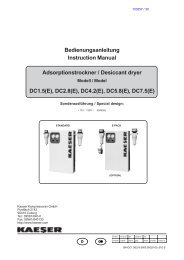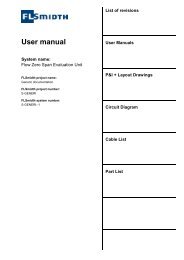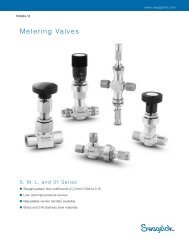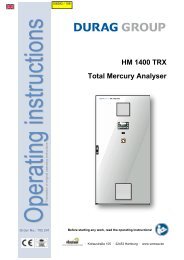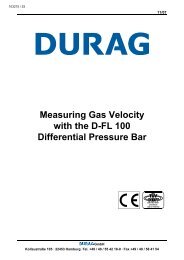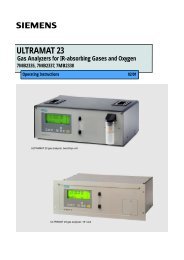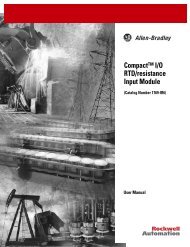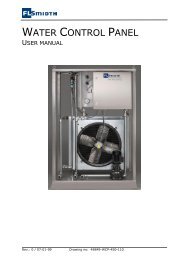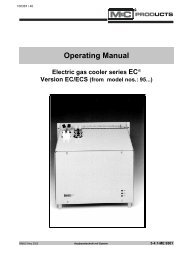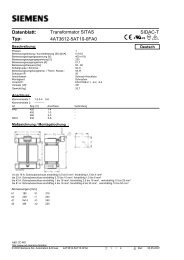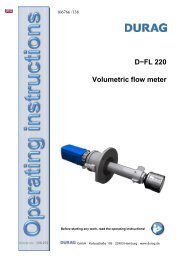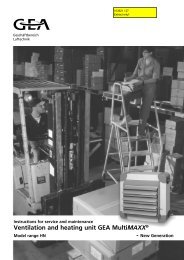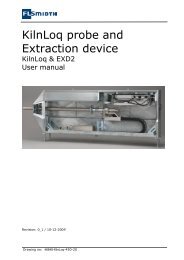Operating Manual - Webshop, Gas Analysis Technology
Operating Manual - Webshop, Gas Analysis Technology
Operating Manual - Webshop, Gas Analysis Technology
Create successful ePaper yourself
Turn your PDF publications into a flip-book with our unique Google optimized e-Paper software.
<strong>Operating</strong> <strong>Manual</strong>Low-temperature electric gas cooler series EC ®version EC30 and EC-30/FD<strong>Gas</strong> sampling and gas conditioning technology3-4.20-ME
3List of IllustrationsFigure 1 Example of application of EC-30/FD .................................................................................. 9Figure 2 EC-30 with options EC-F and EC-FD .............................................................................. 11Figure 3 Schematic diagram of functioning of heat exchanger ...................................................... 12Figure 4 Tubing of the heat exchangers ........................................................................................ 13Figure 5 Timing schematic of the switching processes .................................................................. 13Figure 6 Position of terminal X0 ..................................................................................................... 17Figure 7 Electrical connections ...................................................................................................... 17Figure 8 Change of the pump tube ................................................................................................ 21Figure 9 EC automatic control board ............................................................................................. 26Figure 10 Connection diagram for compressor ................................................................................ 27Figure 11 Temperature adjustment .................................................................................................. 28Figure 12 Voltage in relation to the temperature of the cooling stage ............................................. 29Figure 13 Resistance-temperature characteristics of the PT100 temperature sensor ..................... 29Figure 14 Sensor voltage as function of temperature ...................................................................... 30Figure 15 EC30 control board .......................................................................................................... 31Figure 17 Sample outlet dew point .................................................................................................. 36Figure 18 Circuit diagram EC automatic control board .................................................................... 37Figure 19 Circuit Diagram EC-30 ..................................................................................................... 38Figure 20 Circuit diagram control electronic EC-30 ......................................................................... 39Figure 21 Wiring plan automatic condensate removal unit EC-FD .................................................. 40<strong>Gas</strong> sampling and gas conditioning technology3-4.20-ME
4Dear customer,we have made up this operating manual in such a way that all necessary information about theproduct can be found and understood quickly and easily.Should you still have any question, please do not hesitate to contact M&C directly or go through yourappointed dealer. Respective contact addresses are to be found in the annexe to this operatingmanual.Please also contact our homepage www.mc-techgroup.com for further information about ourproducts. There, you can read or download the data sheets and operating manuals of all M&Cproducts as well as further information in German, English and French.This <strong>Operating</strong> <strong>Manual</strong> does not claim completeness and may besubject to technical modifications.© 04/2000 M&C TechGroup Germany GmbH. Reproduction of thisdocument or its content is not allowed without permission from M&C.3rd Edition: 11/2001<strong>Gas</strong> sampling and gas conditioning technology3-4.20-ME
5Head OfficeM&C TechGroup Germany GmbH Rehhecke 79 40885 Ratingen GermanyTelephone: 02102 / 935 - 0Fax: 02102 / 935 - 111E - mail: info@mc-techgroup.comwww.mc-techgroup.com1 GENERAL INFORMATIONThe product described in this operating manual has been examined before delivery and left our worksin perfect condition related to safety regulations. In order to keep this condition and to guarantee asafe operation, it is important to heed the notes and prescriptions made in this operating manual.Furthermore, attention must be paid to appropriate transportation, correct storage, as well asprofessional installation and maintenance work.All necessary information a skilled staff will need for appropriate use of this product are given in thisoperating manual.2 DECLARATION OF CONFORMITYCE - CertificationThe product described in this operating manual complies with the following EC directives:EMV-InstructionThe requirements of the EC directive 89/336/EWG “Electromagnetic compatibility“ are met.Low Voltage DirectiveThe requirement of the EC directive 72/23/EWG “Low Voltage Directive“ are met.The compliance with this EC directive has been examined according to DIN EN 61010 (correspondsto IEC 61010).Declaration of conformityThe EU Declaration of conformity can be downloaded from the M&C homepage or directly requestedfrom M&C.<strong>Gas</strong> sampling and gas conditioning technology3-4.20-ME
63 SAFETY INSTRUCTIONSPlease take care of the following basic safety procedures when mounting, starting up oroperating this equipment:Read this operating manual before starting up and use of the equipment. The information andwarnings given in this operating manual must be heeded.Any work on electrical equipment is only to be carried out by trained specialists as per the regulationscurrently in force.Attention must be paid to the requirements of VDE 0100 (IEC 364) when setting high-power electricalunits with nominal voltages of up to 1000 V, together with the associated standards and stipulations.Check the details on the type plate to ensure that the equipment is connected to the correct mainsvoltage.Protection against touching dangerously high electrical voltages:Before opening the equipment, it must be switched off and hold no voltages. This also applies to anyexternal control circuits that are connected.The device is only to be used within the permitted range of temperatures and pressures.Check that the location is weather-protected. It should not be subject to either direct rain or moisture.The device must not be used in hazardous areas.Installation, maintenance, monitoring and any repairs may only be done by authorized personnel withrespect to the relevant stipulations.4 WARRANTYIf the equipment fails, please contact M&C directly or else go through your M&C authorised dealer.We offer a one year warranty as of the day of delivery as per our normal terms and conditions of sale,and assuming technically correct operation of the unit. Consumables are hereby excluded. The termsof the warranty cover repair at the factory at no cost or the replacement at no cost of the equipmentfree ex user location. Reshipments must be send in a sufficient and proper protective packaging.<strong>Gas</strong> sampling and gas conditioning technology3-4.20-ME
75 USED TERMS AND SIGNAL INDICATIONSDANGER!WARNING!CARE!This means that death, severe physical injuries and/or importantmaterial damages will occur in case the respective safety measuresare not fulfilled.This means that death, severe physical injuries and/or importantmaterial damages may occur in case the respective safetymeasures are not fulfilled.This means that minor physical injuries may occur in case therespective safety measures are not fulfilled.CARE!ATTENTION!Without the warning triangle means that a material damage mayoccur in case the respective safety measures are not met.This means that an unintentional situation or an unintentional statusmay occur in case the respective note is not respected.These are important information about the product or parts of theoperating manual which require user’s attention.NOTE!SKILLED STAFFThese are persons with necessary qualification who are familiar withinstallation, use and maintenance of the product.<strong>Gas</strong> sampling and gas conditioning technology3-4.20-ME
86 INTRODUCTIONThe patented M&C EC30 gas cooler with universal unit EC-F and EC-30/FD with unit EC-FD is alwaysto be installed in situations where there is interference from moisture in the gas to be measured, or ifthe measured components exhibit very high sensitivity to water vapour or if long and expensive heatedsampling lines are to be avoided.Reduction of the gas temperature inside the cooler to a stable and very low dew point effects acondensing out of the sample gas. Dry gas leaves the gas cooler and passes into the analyser aftersuitable filtration. When installing the EC30(/FD) gas cooler on site in a frost-free protective housing,there is no need to use a heated sample line with a high energy consumption as long as the ambienttemperature does not fall below a value of -25 C.6.1 SERIAL NUMBERThe type plate with the serial number is located at the side panel of the cooler housing (19“ version).Whenever you call M&C regarding questions or orders for the spares please give us the serial numberof your EC30.<strong>Gas</strong> sampling and gas conditioning technology3-4.20-ME
97 APPLICATIONThe patented M&C ultra-low temperature cooler EC-30(/FD) finds its applications in the analytical fieldfor reducing the dew point of humid sample gases, providing a stable and very low dew point andreducing aerosol formation in the analyser. By mounting the cooler near to the sample point, costlyenergy consuming heated sample lines can be avoided. An extremely stable and low gas dew pointavoids water vapour cross-sensitivity and volumetric errors.Figure 1 shows a typical example of an application for installation of an EC-30 gas cooler unit.EC-301Sample gas INEC-Samplegas OUTCondensateOUTTest gasINFilter sample probe SP... Universal unit EC-FD Membrane pump AnalyserHeated sample line 3-way-ball valve Flow meter FMEC-30/FD cooler Super-fine filter FP... Aerosol filter CLFDeep cooling stage 1 Deep cooling stage 2 Pre cooling stageFigure 1 Example of application of EC-30/FDThe gas to be measured is taken from the EC-30/FD gas cooler by a gas sample probe andcooled down to a dew point of -30°C. Via the universal unit EC-FD the condensate is removed. Thesuper-fine filter located afterwards removes solid particles. For increased operating safety of theentire system we recommend installing a super-fine filter with a liquid alarm sensor. If required anaerosol filter can be installed in front of the flow meter . The gas thus treated can now be passedinto the analyser . Via the 3-way-ball valve it is possible to feed test gas for calibration to theanalyser.<strong>Gas</strong> sampling and gas conditioning technology3-4.20-ME
108 TECHNICAL DATACooler series EC ® Version EC-30 Version EC-30/FDPart No. 02K6000 (a)** 02K6010 (a)**With integrated universal unit: EC-F to force the ventilation EC-FD ventilation andcondensate removal<strong>Gas</strong> connectiontube connector DN 4/6 i./o. d. mmCondensate connections 3x tube connector GL25-12 mm 1x tube connector DN 4/6 i./o. d.mmMaterial of sample contacting parts Duran glass, PTFE, PVDF Duran glass, PTFE, PVDF,NovopreneSingle stream, gas flow rate90 Nl/hr-250 Nl/hr*<strong>Gas</strong> pressure max. 3 bar abs. max. 2 bar abs.Ambient temperature +5 to +45 °CSample outlet dew point -30 °CSample inlet temperaturemax. 180 °C*Sample inlet dew pointmax. 80 °C*Cooling capacity at 25 °C ambient max. 860 kJ/hr*Main power connection / Power 230V 50Hz 380VA or **Part No. ...-a = 115V 60 Hz 380VAconsumptionStart up time< 60 min.Stagnant spaceapprox.160 mlP at 250 Nl/hr flow rate5 mbarElectrical connection2,5 mm 2 terminals, 2x PG13,5 cable glandsStatus alarm 2 changeover contacts, potential free contact rating 250V, 3A,500VA, 50WCase protection / Electrical equipment IP20 EN 60529 / EN 61010standardMethod of mounting / Case colour 19" rack or wall / case colour RAL 7032Dimension / Weight 84 TE x 8 HE x 360 mm / 37 kg 84 TE x 10 HE x 360 mm / 42 kg** Maximum values in technical datas must be rated in consideration of total cooling capacity at 25 °C ambient temperature and an outletdew point of 5 °C.9 DESCRIPTIONThe patented M&C gas cooler EC-30(/FD) is a two stage combination of compressor and Peltiercooler with status alarm and automatic defrosting of the dual deep freezer unit for 100% sampleavailability. The pre-cooler of the gas cooler EC- is fitted with a “Jet-Stream“ heat exchanger EC-Gwhich is cooled by a compressor cooling unit with electronic control at a constant temperature of +1°C.Optimum cooling of sample gases and pre-elemination of a larger part of the condensate from the gasis reliably achieved. No external pre-draining is normally needed. The deep freezer and is cooledwith two modified “Jet-Stream“ heat exchangers EC-30 fitted between two automatic cooling units for aminimum temperature of -30 °C. The special design of the Jet-Stream heat exchanger guaranteesoptimum dew point reduction to a low, stable value and secures condensate separation. The gasoutlets of the heat exchangers are connected to a 3/2 way solenoid valve. An electronic control systemEC-30 switches the solenoid valve for simultaneous changeover and automatic defrosting of the heatexchangers EC-30. In order to guarantee the necessary and minimum operation of the gas cooler EC-30, we provide this unit with an accessory module EC-F containing two fans for forced air ventilationand cooling of the compressor unit. Alternative we deliver the cooler with the module EC-FDcontaining additionally three peristaltic pumps SR-25.1 for automatic removal of condensate.<strong>Gas</strong> sampling and gas conditioning technology3-4.20-ME
119.1 ASSEMBLY Figure 2 EC-30 with options EC-F and EC-FD<strong>Gas</strong> sampling and gas conditioning technology3-4.20-ME
1210 FUNCTIONThe patented M&C EC30(/FD) gas cooler is a combined two stage compressor Peltier cooler withstatus alarm capability. Automatic defrosting of the double-construction low temperature stage ensures100% availability of the cooler. The pre-cooling stage (see fig. 1) of the cooler is equipped with a jetstream EC heat exchanger made of Duran glass. Figure 3 shows a schematic diagram of thefunctioning of the heat exchanger.Sample gasoutSample gasinThe EC30 is equally suitable for wall installation or mounting in a 19” rack. The versions differ in thepositioning of the LED function display . While for wall installation the LED function display can befitted into the corresponding cut-outs in the EC30 front panel, for 19” rack mounting this is done usingthe cut-outs in the back panel of the casing. This positioning is done at the factory when stating thetype of installation of the EC30 gas cooler. It is relatively simple to subsequently reconfigure it on siteat the user location. The location for installation of the LED function display is markedcorrespondingly.On the upper side of the cooler casing you will see the cut-outs for the heat exchangers of the precoolingstage and for the two low-temperature stages and . Sample gas enters the pre-coolingstage at the 4/6 hose connection on the upper part of the heat exchanger. At the rear part of thecasing the condenser to remove heat given off in the compressor can be seen. The mains powerconnector, EC automatic control board and EC30 control board with the contact outputs for the statusalarm are located in two plastic housings respectively behind the removable front panel of the EC30casing.On the underside of the casing the following connections are provided as standard: cable glandsPG13,5 to the plastic housings ; condensate outlets GL25/12 from the heat exchangers ,and ; sample gas outlet DN4/6.As standard, the condensate is removed externally with collecting vessels, peristaltic pumps, or by”over-pressure operation”, with automatic float condensate traps, as e.g. type AD-... The heat energyfrom the cooling system is drawn off by a forced-ventilation . The required fans and large airsuction filter elements are provided as standard in universal unit EC-f . This is arranged below theEC30 casing and is absolutely essential for operation of the cooler unit. Optionally, the universal unitEC-F can be replaced by an automatic condensate removal unit EC-FD 12 , which is likewise locatedbelow the casing of the cooler. Apart from the above-mentioned condenser forced ventilation, the EC-FD unit has three peristaltic pumps of type SR25.1 13 for automatic condensate removal. This can alsobe set in underpressure operation (suction operation).The connections for the sample gas outlet and the condensate outlet 11 are located in the frontpanel of the EC-FD unit.Coolingblock+5°CCondensate outFigure 3 Schematic diagram of functioning of heat exchanger<strong>Gas</strong> sampling and gas conditioning technology3-4.20-ME
A decoupled compressor cooler system has a heat-insulated cooling block at a constant temperatureof +1 C. Control of the compressor is contactless done by the EC automatic control electronics and istherefore not subject to wear. The pre-cooling stage ensures that the greater part of the condensatehas already been removed from the gas stream.The low-temperature stages are provided with two modified jet stream EC30 heat exchangers made ofDuran glass. These are cooled down to a temperature of around -30 C by two completely independentPeltier element cooling systems.Stages and (see fig. 1) of the gas cooler work intermittently at intervals of three hours. While onestage is in operation, the other one is automatically defrosted. All the heat exchangers are easilyaccessible and are arranged in such a way that they can be removed very simply. Switching over thegas flow is done by a 3/2-way solenoid valve made of PVDF/Viton (see fig. 4). This arrangementexcludes any possibility of water vapour being sucked back from the low-temperature stage that isbeing defrosted.13Deep cooling stagesSample gasOUPre-cooling stageSample gasINFigure 4 Tubing of the heat exchangersThe EC30 control electronic switches the solenoid valve every three hours and at the same timecarries out the alternating defrosting process of the low-temperature heat exchangers.3 hr 3 hr 3 hr 3 hro.k.AlarmChannel 2Channel 1StatusSolenoid valve1 hr-30°C+5°C-30°C+5°CTemperature channel 2Temperature channel 1+1°CEC pre-coolerAmbient temperaturePower ON, startPower OFFFigure 5 Timing schematic of the switching processes<strong>Gas</strong> sampling and gas conditioning technology3-4.20-ME
The heat energy from the cooling system is drawn off by the forced ventilated condenser. The LEDfunction display on the front of the cooler shows the operating status. Alarm warnings for over- andunder-temperature are given as a collective status alarm via a relais output with two potential-freechangeover contacts.1411 RECEPTION AND STORAGEThe EC-30(/FD) gas cooler is a complete pre-installed unit.Carefully inspect the EC-30(/FD) and any special accessories included immediately on arrival byremoving them from the packing and checking for missing articles against the packing list!Check the items for any damage in transit and, if required, inform the shipping insurancecompany immediately of the damage found!The tubing for the heat exchangers is dismounted for shipping and it is separately inside of thepackage.NOTE!NOTE!The cooler must be stored in a weather-protected frost-free area!During transport and when in storage, the cooler has always to stand verticalwith the transport feet positioned underneath so that the oil in the closedcompressor circuit cannot run out of this compressor case. If the cooler istransported on its back by mistake, it has to stand in the operating positionfor approx. 24 hours before it is switched on!<strong>Gas</strong> sampling and gas conditioning technology3-4.20-ME
1512 INSTALLATION INSTRUCTIONSThe EC-30(/FD) cooler is equally suitable for wall mounting or for installation in a 19" rack.NOTE!Please state the desired type of mounting when ordering, so that the LEDfunction display can be positioned to match at the factory!NOTE!The operating position for this cooler is exclusively vertical. This is the onlyway to ensure proper separation and removal of condensate in the heatexchangers. During transport and when in storage, the cooler has always tostand vertical with the transport feet positioned underneath so that the oil inthe closed compressor circuit cannot run out of this compressor case.The cooler should be kept away from sources of heat and well ventilatedwhen installed, to avoid interfering heat accumulation.The minimum installation dimensions (fig. 2) must be followed without fail. Ifthe unit is installed outdoors, the cooler must be installed in a housing thatis frost-free in winter and adequately ventilated in summer. Avoid locatingthe unit in direct sunlight.Unheated gas sample lines have to be run with slope up to the cooler. In thatcase pre-separation of the condensate is not required.Connect the heated sample line with sufficient thermal decoupling to thecooler!13 SUPPLY CONNECTIONS13.1 HOSE CONNECTIONSThe hoses for the heat exchangers are connected as shown in figure 4.NOTE!Do not mix up the hose connections; the inlet and outlet connections of theheat exchangers are marked with arrows;Exit hose of the low-temperature stage (fig. 4) is marked red.Ensure that the connections are sealed adequately;To ensure free removal of the condensate, ensure that the listed diametersfor the condensate removal lines are not reduced!Ensure that the connections are sealed adequately by noting the following:Duran glass heat exchangers with GL connectionsBefore assembly, check the GL coupling rings to see if the PTFE/silicon locking rings have beendamaged;The locking rings should be installed with the PTFE side facing the medium.PVDF heat exchangers with PVDF tube connectorsCarefully remove the nuts from the coupling body so that the ferrule that is loose inside the nutwill not be lost.Push the union nut first, and then the ferrule with the thick bulb facing the nut, onto the 4/6 mmhose.Push the hose onto the support nipple in the coupling body and tighten the union nut hand-tight.<strong>Gas</strong> sampling and gas conditioning technology3-4.20-ME
16N O TE!When fixing the connectors in the PVDF heatexchanger hold upwith awrench at the pane of the bolt head!The connection for the gas inlet (see above) is made to the heat exchangerof the pre-cooling stage 3( (fig. 2). Thiss is markedaccordingly with ann arrow.The outlet for gas to be measured, DN 4/6, is located asstandardd on theuniversal unit EC-F locatedon the underside of the cooler casing (fig. 2).When using the automatic condensate removal EC-FD, the connection forthe outlet for gas to be measured will be made to the correspondingconnector on the front panel of the universal unit(fig. 2).In the standardd configuration, the tubes for removal of condensate are connected directly tothe heatexchangers.These protrudewith the 12mm tube connectors above the base plate of the cooler casing (fig. 2).Condensate removal is done according to the type of operation with:Universal unit EC-FD with peristaltic pumps for automatic condensate removal;Automatic float condensate trap and remover AD-... only for over-pressuree operation;Condensate collector container that has to be drained manually.13.2ELECTRICAL CONNECTIONSWARNING!When connectingthe equipment, please ensuree that the supplyvoltage is identical with theinformation provided on themodeltype plate.NOTE!Attentionn must bepaid to the requirements of IEC 364 (DIN VDE0100) when setting high-power electrical units with nominalvoltagesof up to 1000 V, together with the associated standardsand stipulations.Check the details on the typeplate to ensure thatt the equipment isconnected up to the correct mains voltage.The main circuit must be equipped with a fuse of 10AT (overcurrent protection) ); for electrical detailssee technical data.<strong>Gas</strong> sampling andgas conditioning technology3-4.20-ME
17Figure 6 shows the location of the terminal X0 behind the front panel of the EC-30 casing (fig. 2).EC-electronicPre-coolerEC30-electronicdeepEC30 power supplySolenoid valveSample gas switchingTerminal X0from deepcooling stagefrom deepcooling stage2 x PG 13,5Power supply : 230V/50Hz or 115V/60Hz (see type plate)Status alarm : two potential free changeover contactsContact rating : 250V AC, 2A, 500VA or250V DC, 2A, 50WFigure 6 Position of terminal X0Two PG 13,5 cable glands are provided for the cable bushings through the base plate of the coolercasing. Power and alarms have to be connected as shown in the pin configuration in Figure 7 below:Power connection toEC electronicsAlarm connection toEC electronicsX01 2 3 4 5 6 7 8 9 10LNPENC MC NONC MC NOPower Inby customerAlarm connection bycustomerFigure 7 Electrical connections<strong>Gas</strong> sampling and gas conditioning technology3-4.20-ME
1814 START-UPThe control electronics of the EC30(/FD) permit automatic start up of the cooler, which also ensuressafe and guaranteed operation regardless of external influences such as a power failure. The errordiagnostics guarantee full monitoring and reporting of possible sources of error. The followingdescription is valid for startup of the gas cooler for an ambient temperature > 5 C.NOTE!Before starting up the gas cooler, it must be placed in its operating positionfor at least two hours. The liquid inside the system may has beenredistributed, and this could cause problems in operating!The following steps should be carried out before initial start up:Connect the cooler unit to the mains power supply; Check that the equipment is connected tothe correct mains voltage, 115V or 230V, as shown on the type plate.Lead the status contacts for reporting of low- and excess temperature to the measuring station.NOTE!The status contacts must be connected to the external sample gas pump orto a valve in the sample gas line to protect the entire analysis system byimmediately cutting off the gas supply in the event of error messages fromthe cooler!14.1 FUNCTION SEQUENCE AND LED FUNCTION DISPLAYThree function display LEDs are provided to give a visualization of the function sequence during startup of the cooler. According to the type of installation, they are located either on the front panel or theback panel of the cooler (fig. 2). The top LED (red) indicates that the temperature set by the ECautomatic control electronics for the pre-cooler stage has been exceeded or has not been reached.The two-colour (pink/green) LED in the middle shows that the cooler compressor is operating (on/off).The bottom red function display LED gives an alarm if the pre-cooler stage temperature falls too low orif the low-temperature stage temperature is exceeded.Switching the cooler onAs soon as there is a mains voltage, the top red LED lights up. Thisindicates that the temperature of the pre-cooler is min. 3 C above the settemperature of +1 C. The two-coloured LED in the middle lights up as pinkonce the cooler compressor is in operation.°C >ONredpinkgreen°C
19Switching on the low-temperature stagesAfter approx. 30 minutes the pre-cooler stage has been cooled down to atemperature below +4 C. The top red LED goes out and the bottom red LEDlights up. The low-temperature stage is activated and starts operating atfull power. The cooler compressor is switched of as soon as the pre-coolerstage reaches the controlled temperature of +1 C. The middle LED lights upgreen. The cooler compressor will be alternately switched on and off by theEC automatic control electronics in a load-dependent cycle. The middle LEDwill alternately light up pink and green (normal operating functions).°C >ONpinkgreen°C ONpinkgreen°C
2015CLOSING DOWNNOTE!The location for the cooler must remain frost-free, even when theunit has been switched off!If thecooler unit is put out of operation for a short time no particular measures have to be taken.We recommendpurging the cooler with inert gas or ambient air, whilethe unit isput out of operationfor a longer time.WARNING!Aggressive condensate is possible.Wear protective glasses and proper protective clothing!16MAINTENANCEEThe safety instructions specific to theplant and process areto be consulted priorr to any maintenancework!WARNING!Dangerous voltage!Before opening thehousing please disconnect the cooler from themains supply!TheEC-30(/FD) cooler unit does not require anyspecial maintenanceintervals.Depending on the degree of contamination of the ambient air the cooling fins of the condenser haveto be cleaned periodicallywith pressure air and the air suction filter units in the EC-F / EC-FDuniversal unit have to be cleaned or replaced. They arelocated ina plug-in box underneath thecooler unit. Thefilter elements are removed as follows:Unclamp the plug-in box by turning the quick-lock screw plug 90to the left;Pull out the box;Removee the crossbars holdingthe filter element by pulling withmoderate force in thedirectionof the filter elementaxis;Removee and replace the filter elements.Reassembly is done in thereverse order.<strong>Gas</strong> sampling andgas conditioning technology3-4.20-ME
2116.1 MAINTENANCE OF THE PERISTALTICPUMPS TYPE SR25.1 OF THE EC-30/FDBefore the maintenance work is carried out, it is necessarypertainingto the system and operational process are observed!that the specific safety proceduresDANGERDangerous voltage!It is necessary to take thepump offf the mains before any assembly,maintenance and repair work is carried out!Flexible tube, conveying belt, contact pulleys and contact springs are the only parts of the pumpsubject towear. They are easy to change.16.1.1 CHANGE OF THE PUMP TUBECARE!Aggressive condensate is possible!Wear protective glasses and proper protective clothing!NOTE!If yousend back the peristaltic pump to the M&C service for repair,pleasee let us know what kind of condensate has been pumped.Before sendingthe pumpp back clean all parts from dangerous orhighlyaggressive contaminants.2431Figure 8 Change of the pump tubeTake off the cooler of themains;Open hose connectors at the pump;Press conveying belt at the recessed grips and turn S-boltclockwise up tolimit stop;<strong>Gas</strong> sampling and gas conditioning technology3-4.20-ME
22Take away conveying beltconnectors;and remove the old hose set from thee guides bythe hosePress the two contact pulleys and check whetherthe spring pressure isstill sufficient, if not,the contact springss have to bechanged;Put the new hose set with the hose connectors into the guides of the conveying belt ;NOTE!Only the usage of the original hoseset guarantees a perfect function.Never lubricate the hose.Before mounting the pump check all parts for impurity and clean ifnecessary.Put the conveying belt with the new hoseinto the dovetail guide of the pump body;Press conveying belt at the recessed grips and simultaneouslyturn the S-boltanticlockwiseuntil it snaps;Switch on pump.16.1.2 CHANGE OF CONTACT PULLEYS AND SPRINGSTake offf the coolerof the mains;Unscrewthe nut ofthe pump head (span of the jaw 5,5);Draw the pump head out of the motor shaft; Now thedriver canbe taken out of the pump headand is ready for maintenance.To remove the springs (4 pcs.) of the driver is possible without the aid ofany tools. Thereforepress the spring together andtake it out of the groove in the driver respectivelyout of theboring in the axle. Now the roller bearingaxle can be dismounted and the contact pulleys areready for change.Remounting in reverse order.NOTE!While mounting pay attention to the fit of ‘rotational axis driver’. .Usegenuine spare partsonly!16.1.3 CLEANING THEPUMP HEADWhen changing flexible tube or other parts, inspect all partsfor dirt before assembling thepump head and clean them if necessary.Clean the parts with a dry cloth as far as possible.Solvents should not be used asthey canattack the plastics and synthetic rubber parts. If a compressedair line is available, blow out theparts with pressuree air.CARE!Aggressive sample is possible!Wear protective glassesanddisassembly,repair or cleaning!properprotectiveclothingduring<strong>Gas</strong> sampling andgas conditioning technology3-4.20-ME
2316.2 REPLACING THE HEAT EXCHANGERSRemoval of the heat exchangers may be necessary to carry out maintenance or repair work. It ispossible to replace the heat exchanger (pre-cooling stage) without switching off the entire cooler.This does not apply to the heat exchangers of the low-temperature stages and . Icing-up atoperating temperatures of -30 C will make it impossible to dismantle the unit. It will take approximatelytwo hours to defrost after switching off the cooler. We recommend the following procedures forreplacement of the heat exchangers in the following order:Release the GL coupling rings by turning them to the left at the upper gas connections andlower condensate connections to the glass heat exchangers;Pull the heat exchangers upwards with rotation out of the cooling block;Dry and clean the push-in opening in the aluminium cooling block with a cloth;Smear thermal conductivity paste (part no. 90K0115) on the heat exchangers with a thin andequal layer over the whole surface to ensure good conduction of heat. It is best to shut thecondensate outlet of the heat exchangers with adhesive tape to prevent any of the thermalconductivity paste from getting into the heat exchanger;Lightly push the heat exchangers back into the opening of the cooling block and press to theupper limit stop;Remove the adhesive tape and any surplus thermal conductivity paste;Reconnect the hoses as shown in the flow diagram (fig. 4).NOTE!Do not mix up the hose connections; the outlet hose for the low temperaturestage is marked in red!Check the PTFE/Silicon locking rings for damage. In assembly, the locking rings must have thePTFE side facing the medium, otherwise the required degree of sealing cannot be guaranteed!Screw on the red GL coupling rings hand tight by turning them to the right.<strong>Gas</strong> sampling and gas conditioning technology3-4.20-ME
2417 TROUBLE SHOOTINGTroubleshooting is made much easier by the LED function display.The following table shows possible reasons for error and how to correct them (not applicable for therunning-up phase of the cooler).LED display°C >ONFunction errorand statusalarmEquipmentdoes not cool;Probable causeNo mains power;Checking / CorrectionCheck the mains voltage 230V (115V) at terminal X0(see Fig. 6 and 7);If mains voltage OK:replace defective EC automatic control board.°C ON°C ON°C 4°C (>0,4V):Check PT100 temperature sensor (19.1);If not OK:Replace sensor;If sensor and electronics OK:Send cooler in for repair.<strong>Gas</strong> sampling and gas conditioning technology3-4.20-ME
LED display°C >ON green°C < redFunction errorand statusalarmEquipment doesnot cool;Cooler has beenover-cooled (temp.< - 2°C);Probable causeAmbienttemperature < -2°CCooling compressorstopped;Cooling compressorruns continuously;Checking / CorrectionAmbient temperature must be+5°C!Check temperature at EC automatic control board(18.2);If temperature < 2°C (< 0,2V):Check PT100 temperature sensor (19.1);If not OK:Replace sensor.Solid-state relay defective;Replace EC automatic control board;25°C >ONgreenpinkLow-temperaturefunction affected;Low temperaturestages defectiveCheck the fine fuses in the EC30 mains supply;if o.k.:Check the voltage at pins 20/21 and 21/22 of theEC30 automatic control board (Fig. 15);°C 12V:Check the voltage for the EC30 temperaturesensors on the EC30 control board at pins 27/28and 33/34 (19.2);if voltage > 2,83V (> +10 C):Replace the relevant sensors;Peltier elements;if voltage < 2,83V (< +10 C):Check the voltage of the Peltier elements at pins23/26, channel , and pins 29/32, channel (Fig.15)if voltage for channel thus controlled (LED D16/D17) = 13VDC:Peltier element is defective; send cooler in forrepair;Heatexchangerfrozen upNo gas flow,sample gas pumpruns;Peristaltic pumpdefective;<strong>Gas</strong> flow too lowCheck peristaltic pump SR25.1if o.k.:Raise gas flow to min. 100l/h;<strong>Gas</strong> sampling and gas conditioning technology3-4.20-ME
2618EC AUTOMATICCONTROL BOARDFigure 7 showss the arrangement of the EC automatic control board of the pre-cooling stagescheme in Appendix).(wiringFigure 9 EC automatic control board<strong>Gas</strong> sampling andgas conditioning technology3-4.20-ME
2718.1 CONNECTING THE COOLING COMPRESSORThe cooling compressor is connected to the EC automatic control board (Fig. 9). Figure 10 shows theconnection diagram for the compressor.Condenser230V 80uFPart No.:90K1055115V 160uFPart No.:90K1060Connection cablePart No.: KL0001cable No.1PE green/yellowcable Nr.1 from EC automatic control board pin 21cable Nr.2 from EC automatic control board pin 24cable Nr.3 from EC automatic control board pin 22PE green/yellow from EC automatic control boardpin 23Control line Part No.: KL0002from EC automatic control electronicscable No.3Flat pin terminal Part No.: KS5006cable No.2MotorbreakerKlixon 230V Part No. : 90K1046Klixon 115V Part No.: 90K1051Cable no. compressor 1 2 3 PE green/yellowEC automatic control board 21 24 22 23Figure 10 Connection diagram for compressor<strong>Gas</strong> sampling and gas conditioning technology3-4.20-ME
2818.2 TEMPERATURE SETTING FOR THE COOLERThe pre-cooling stage is set at the factory to a regulated temperature of +1°C.RUrefCurrent-Temp.P3+ °C -UtempUrefR i > 100kC9Setting-Temp.Connect a d.c. voltmeterto terminals 1, 2 and 3!Figure 11 Temperature adjustmentSetting of the regulated temperature is done by trimming potentiometer P3, on the EC automaticcontrol board of the cooler. The setting range covers temperatures from 0°C to 20°C. Turning it to theright sets a lower temperature, and turning it to the left sets a higher temperature.Connecting an external voltmeter to plugs 2 and 3 allows the nominal set temperature to be read offand controlled. A voltage value of 0.1V corresponds to a temperature of 1°C.It is possible to measure and control the current temperature at measuring sockets 1 and 2.NOTE!Freezing up in the pre-cooling stage will endanger the operation of thecooler unit. For this reason the cooler temperature must never fall below+1°C!19 TEMPERATURE SENSORSThe pre-cooling stage temperature sensor is a PT100 element. STP 35 temperature sensors areavailable for the low temperature stages and .19.1 CHECKING THE TEMPERATURE SENSOR OF THE PRE-COOLING STAGEThere are two methods for checking the PT100 element, as follows:Voltage methodIn order to check the sensor for the cooler currently in operation, the actual voltage at the measuringsockets 1 and 2 of the EC automatic control board must be measured as per section 18.2 above.<strong>Gas</strong> sampling and gas conditioning technology3-4.20-ME
Figure 12 shows the voltage characteristics in relation to temperature. If the measured voltage isinside the shaded area, the sensor is defective and has to be replaced.V43210-1-2-3-30 -20 -10 0 10 20 30 40°CFigure 12 Voltage in relation to the temperature of the cooling stage29Resistance methodIn this case the sensor must be disconnected from pins 1 and 2 at the EC automatic control board(Fig. 9) and removed from the cooling block. When measuring the resistance of the PT100 element,this must be proportional to the ambient temperature. The resistance-temperature characteristics areshown in Figure 13 below.Ohm117115113111109107105103101999795-10 0 10 20 30 40Figure 13 Resistance-temperature characteristics of the PT100 temperature sensor°C19.2 CHECKING THE TEMPERATURE SENSOR OF THE DEEP COOLING STAGEIn order to check the sensors for the low-temperature stages and , the voltage at the EC30 controlboard should be measured between pins 27 and 28 (fig. 15) for channel 1 and between pins 33 and34 for channel 2. Figure 14 allocates a corresponding voltage value for a given temperature value.This should be compared with the measured voltage value.<strong>Gas</strong> sampling and gas conditioning technology3-4.20-ME
30Figure 14 Sensor voltage as function of temperatureIf the measured voltage is inside the shaded area, the sensor is defective and has to be replaced.<strong>Gas</strong> sampling and gas conditioning technology3-4.20-ME
3120 EC CONTROL BOARDFigure 15 shows the layout of the EC30 control board (wiring diagram in appendix).<strong>Operating</strong> indicationChannelHeatingChannel 2 Channel 1Temperatureadjustment(zero)Alarm threshold(
3220.1 FUNCTION SEQUENCE OF THE EC30 CONTROL ELECTRONICSNine LEDs are available for error diagnosis of the EC30 control electronics to display all the logic andalarm functions.NOTE!Do not change any settings that had been made at the factory!With the potentiometer P1 the temperature (zero point) is adjusted(measuring points M1, M2)Potentiometer P2 figures the alarm < 25°C (measuring point M3).P3 is used to set the automatic time cycle (measuring point M4)The switch S1 is used for factory-made tests. It must always be set inthe higher position, ‘operation’.It is essential to check the setting of switch S1 prior to initial start-up.NOTE!Start up is done by applying a voltage to the cooler unit:LEDs D7 and D10 light up red;LED D16 lights up green;The temperature of the low-temperature stages is > +0°C.Once the pree-cooling stageCooler stage is activated;has reached +4°C after about half an hour:After a short time the temperature of the low-temperature stageLED D7 goes out.After 1 hour total the temperature of the low-temperature stageLED D6 lights up green;LED D19 - status all o.k.- lights up green;The status alarm contact is deactivated;LED D13 - timing cycle active - blinks red.< 0°C:< -25°C:It is now ready for cooler operation. The sample gas flows through the pre-cooling stage and thelow-temperature stage , after which an external release is done by the status alarm contact, so thatthe external sample gas pump or a solenoid valve in the sample gas line can be controlled by thealarm contact. After additional two hours, low-temperature stage will likewise be activated:LED D17 lights up green.After a short time the temperature of the low-temperature stageLED D10 goes out.After half an hour the temperature of the low-temperature stageLED D12 lights up green;< 0°C:is < -25°C:Three hours after low-temperature stage was ready for operation, the solenoid valve will beswitched over to channel 2:LED D18 - solenoid valve channel 2 selected - lights up green;LED D16 - cooling ON channel 1 - goes out.<strong>Gas</strong> sampling and gas conditioning technology3-4.20-ME
The sample gas flows through the pre-cooling stage and low-temperature stage . This cycle willbe changed automatically every three hours.In the event of a brief (mains) power failure:The current cycle status will be stored;All LEDs go out;The status alarm contact is activated;The flow of sample gas is cut off externally, in case the sample gas pump or a solenoid valve inthe sample gas line are to be controlled by an alarm contact.When the mains power is restored:The controller starts up automatically;The status alarm contact is deactivated;The status alarm contact will release the flow of sample gas externally, in case the sample gaspump or a solenoid valve in the sample gas line are controlled by an alarm contact.In the event of a prolonged power failure, the controller will start up automatically like it happens for anew start. Release is only done when the temperature is < -25°C.33<strong>Gas</strong> sampling and gas conditioning technology3-4.20-ME
3421 SPARE PARTS LISTWear, tear and replacement part requirements depend on specific operating conditions.The recommended quantities are based on experience and are not binding.<strong>Gas</strong> cooler EC-30(/FD)(C) Consumable parts(R) Recommended spare parts(S) Spare partsRecommended quantity being inoperation [years]Part No. Indication C/R/S 1 2 302 K 9105 Spare heat exchanger EC-G pre-cooling stage EC30 with GLconnections, Material: Duran glass Connections: Sample gas:2x GL18-8mm, Condensate: 1x GL25-12mm·02 K 9150 EC-G-90° jet stream heat exchangermaterial: Duran glass02 K 9200 EC-SS jet stream heat exchangermaterial: stainless steel02 K 9250 EC-SS/NPT jet stream heat exchangermaterial: stainless steelConnections: sample gas in and out 1/4“NPTicondensate out 3/8“ NPTiR 1 1 1R 1 1 1R 1 1 1R 1 1 102 K 9300 EC-PV jet stream heat exchangerR 1 1 1material: PVDF90 K 6001 Jet stream heat exchanger type EC-G30 for deep cooling stage, R 1 1 1material: Duran glass.90 K 6003 Heat exchanger EC30-PV for the deep cooling stage. R 1 1 190 K 0115 EC thermal conductivity paste 50 g (-40°C to 140°C) R 1 1 290 K 1002 Temperature sensor PT100 for EC automatic control electronics Rfrom model nos.: 95.......90 K 6055 Temperature sensor for EC30 R - - -90 K 1007 EC automatic control board complete for PT100 and contactless R - 1 1compressor control from model nos.: 95.......90 K 0035 Fan (M1/2 - 230V 50Hz) with option EC-F/FD C - 2 290 K 0040 Fan (M1/2 - 115V 60Hz) with option EC-F/FD C - 2 290 K 6045 Fan 80 for EC-30 C - 2 290 K 1035 Solid-state-Relais "RE2" ASP-204 R - 1 190 K 1010 LED function display with connecting cable R - - 190 K 1015 Cooler aggregate complete with compressor, vaporizer andcondenser for EC-30; refrigerant R290, power: 230 V, 50 Hzstandard90 K 1014a Cooler aggregate complete with compressor, vaporizer andcondenser for EC-30; refrigerant R404A, forced ventilated,power: 115 V, 60 Hz90 K 1014 Cooler aggregate complete with compressor, vaporizer andcondenser for EC-30; special quantity of refrigerant R290 forforced ventilation, power: 230 V, 50 Hz with option EC-F/FDR - - -R - - -R - - -90 K 0130 Filter cloth EC-F with option EC-F C 2 4 690 K 0135 Filter cloth EC-FD with option EC-FD C 2 4 690 K 1046 Bimetal switch Klixon 230V R - 1 190 K 1051 Bimetal switch Klixon 115V R - 1 190 K 1055 Capacitor for compressor 80µF-230V R - 1 190 K 1060 Capacitor for compressor 160µF-115V R - 1 190 K 6035 Peltier element EC30 T - - -90 K 6030 Fine fuse 4AT 5x20 R 2 4 6<strong>Gas</strong> sampling and gas conditioning technology3-4.20-ME
3522 APPENDIXSample outlet dew point (ambient temperature 20°C) depending on heat exchanger material,inlet dew point and gas flow rateCircuit diagram EC automatic control board, drawing number : 2300 - 5.04.2Circuit diagram EC30 (from 9/98), drawing number: 2389 - 5.01.3Circuit diagram EC-30-control electronic, drawing number: 2389 - 5.02.3Wiring plan automatic condensate removal unit EC-FD, drawing number : 2300-5.05.0Further product documentation can be seen and downloaded from our home page:www.mc-techgroup.comInstruction manual peristaltic pump SR 25.1, Document : 3-7.1-MD;Condensate vessel TG, TK, Docume nt : 3-6.3.1GL-connectors, Document : 3-5.1.1Universal unit EC-D and EC-FD, Document : 3-4.4Automatic liquid drain AD-SS, Document : 3-6.2.3Automatic liquid drain AD-P, Document : 3-6.2.1<strong>Gas</strong> sampling and gas conditioning technology3-4.20-ME
36Sample outlet dew point (ambient temperature 20°C) depending on gas flow ratesample inlet dew pointSample outlet dew point°C10EC-G60°C40°C562,5N l/hr125 187,5250<strong>Gas</strong> flow rateSample outlet dew point°C10EC-SS562,5N l/hr125 187,5250<strong>Gas</strong> flow rateSample outlet dew point°C10EC-PV562,5125 187,5250<strong>Gas</strong> flow rateN l/hrFigure 16 Sample outlet dew point<strong>Gas</strong> sampling and gas conditioning technology3-4.20-ME
37Figure 17 Circuit diagram EC automatic control board<strong>Gas</strong> sampling and gas conditioning technology3-4.20-ME
38Figure 18 Circuit Diagram EC-30<strong>Gas</strong> sampling and gas conditioning technology3-4.20-ME
39Figure 19 Circuit diagram control electronic EC-30<strong>Gas</strong> sampling and gas conditioning technology3-4.20-ME
40Figure 20 Wiring plan automatic condensate removal unit EC-FD<strong>Gas</strong> sampling and gas conditioning technology3-4.20-ME



